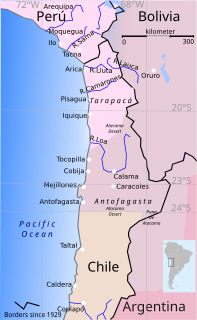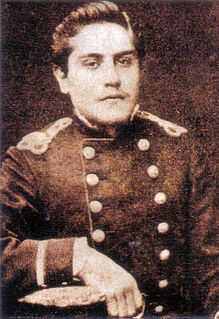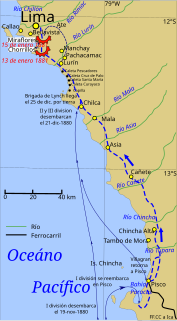
The War of the Pacific, also known as the Saltpeter War and by multiple other names, was a war between Chile and a Bolivian–Peruvian alliance from 1879 to 1884. Fought over Chilean claims on coastal Bolivian territory in the Atacama Desert, the war ended with a Chilean victory, which gained for the country a significant amount of resource-rich territory from Peru and Bolivia. The Chilean Army took Bolivia's nitrate-rich coastal region, and Peru was defeated by the Chilean Navy.

The Battle of Maipú was a battle fought near Santiago, Chile on April 5, 1818, between South American rebels and Spanish royalists, during the Chilean War of Independence. The Patriot rebels led by Argentine general José de San Martín effectively destroyed the Spanish forces commanded by General Mariano Osorio, and completed the independence of the core area of Chile from Spanish domination.

The Battle of Yungay was the final battle of the War of the Confederation, fought on January 20, 1839, near Yungay, Peru. The United Restorer Army, led by Chilean General Manuel Bulnes, consisting mainly of Chileans and 600 North Peruvian dissidents, attacked the Peru-Bolivian Confederation forces led by Andrés de Santa Cruz in northern Peru, 200 kilometers (120 mi) north of Lima.

The Battle of Pisagua, was a landing operation of the War of the Pacific, fought on November 2, 1879, between Chile and the combined forces of Bolivia and Peru. The Chilean army commanded by Erasmo Escala, supported by the Chilean Fleet, launched an amphibious assault on the port of Pisagua and successfully drove the defending Bolivian-Peruvian forces, led by Gen. Juan Buendia, back from the shore. They established a beachhead that allowed an initial force of about 1,000 Chilean soldiers in two assault waves to disembark onto Peruvian territory at Pisagua in Tarapacá Department. This region was the principal territory in dispute.

The Battle of San Francisco, also known as the Battle of Dolores, was a major battle in the Tarapacá Campaign of the War of the Pacific, fought on November 19, 1879, in the Peruvian department of Tarapacá. A Chilean army under Colonel Emilio Sotomayor had moved via Dolores rail road deep into the desert and was encamped at San Francisco Saltpeter Office, about 30 kilometers south east of the port of Pisagua. Allied forces under General Juan Buendía launched an attack on Sotomayor's army. At the beginning, Bolivian General Carlos Villegas pressed the attack over a poorly defended battery right in the Chilean centre and almost succeeded. Only the arrival of infantry support allowed Colonel José Domingo Amunátegui to hold the position.

The Battle of Tarapacá occurred on November 27, 1879, during the Tarapacá Campaign of the War of the Pacific. Three Chilean columns of almost 3,900 soldiers attacked a numerically inferior Peruvian contingent of 3,046 troops at Tarapacá - 500 of which were at Quillahuasa, 1 hour away from the battlefield - commanded by Gen Juan Buendía, resulting in a harsh defeat. The Chilean 2nd Line Regiment was the most damaged unit, losing almost half of its force, along with its commander Col. Eleuterio Ramírez and his second in command, Lt. Col. Bartolomé Vivar. Also, the unit lost its banner, which was recovered six months later after the battle of Tacna. Despite the victory, the Allies could not contest for the domination of the Tarapacá department, abandoning it to Chilean control.

Luis Cruz Martinez was a lieutenant of the 6th. second company of Regiment "Chacabuco" and hero of the Battle of La Concepción, during the War of the Pacific in 1882, in Chilean occupied territory.

The Battle of Huamachuco was fought on the 10 July 1883, and it was the last major battle of the War of the Pacific. The Chilean soldiers, led by Colonel Alejandro Gorostiaga, decisively defeated the Peruvian army commanded by General Andrés Avelino Cáceres near the town of Huamachuco. This Chilean victory effectively eliminated Cáceres' Ejército de la Breña, ending any real threat or resistance in the Peruvian Andes. The Peruvian defeat paved the way for the Treaty of Ancón that finally put an end to the war. Also, one of Peru's greatest heroes, Colonel Leoncio Prado, died as a consequence of this battle.

The War of the Confederation was a military confrontation waged by Chile, along with Peruvian dissidents, and the Argentine Confederation against the Peru–Bolivian Confederation between 1836 and 1839. As a result of the Salaverry-Santa Cruz War, the Peru-Bolivia Confederation was created by General Andrés de Santa Cruz, which caused a power struggle in southern South America, with Chile and the Argentine Confederation, as both distrusted this new and powerful political entity, seeing their geopolitical interests threatened. After some incidents, Chile and the Argentine Confederation declared war on the Peru-Bolivian Confederation, although both waged war separately.

The Battle of Miraflores occurred on January 15, 1881 in the Miraflores District of Lima, Peru. It was an important battle during the War of the Pacific that was fought between Chile and the forces of Peru. The Chilean army led by Gen. Manuel Baquedano defeated the army commanded by Nicolás de Piérola guarding the second defensive line of the Peruvian capital city. Two days later, Lima, the capital city of Peru was occupied by Chilean troops. Gen. Baquedano's forces marched into Lima triumphant, while Peru's president and his officers fled into the interior, leaving the country without any government. Even after the fall of Lima, the war continued between the occupation army and the troops of Andres Caceres for another three years. During the occupation of Lima, Peru's National Library was burned, while a number of other monuments were ransacked by Chilean forces and taken as war trophies.

The Battle of Concepción was a battle fought between Chilean and Peruvian forces on July 9 and July 10, 1882, during the Sierra Campaign of the War of the Pacific. Heavily outnumbered, the Chilean detachment of 77 men under the command of Captain Ignacio Carrera Pinto was annihilated by a 1,300-strong Peruvian force, many of them armed with spears, commanded by Col. Juan Gasto and Ambrosio Salazar after a 27-hour fight in the small town of Concepción in the Peruvian Andes.

The Battle of San Juan, also known as the Battle of San Juan and Chorrillos, was the first of two battles in the Lima Campaign during the War of the Pacific, and was fought on 13 January 1881. This battle is really a group of smaller, yet fierce confrontations at the defensive strongholds of Villa, Chorrillos, Santiago de Surco, San Juan de Miraflores, Santa Teresa and Morro Solar. The Chilean army led by Gen. Manuel Baquedano inflicted a harsh defeat on the Peruvian army commanded by the Supreme Chief Nicolás de Piérola. The Chilean triumph eliminated the first defensive line guarding Lima, and almost obliterated the Peruvian army defending it.

The Battle of Los Ángeles was a military action fought on 22 March 1880 between the Chilean and Peruvian armies during the Tacna and Arica Campaign of the War of the Pacific. The Chilean forces under Commander in chief Manuel Baquedano assaulted and defeated the Allied stronghold guided by Andrés Gamarra garrisoned at Los Angeles hill top.
The Battle of Buin was fought on January 6, 1839, during the Chilean second expedition of the War of the Confederation. The Restoring Army rearguard led by General Manuel Bulnes successfully held the bridge over the Buin River in the North Peruvian territory from the attack of the Confederacy Army commanded by Marshal Andres de Santa Cruz, yet retreated to San Miguel leaving the field before Santa Cruz could engage him again.

The occupation of Lima by the Chilean Army in 1881-1883 was an event in the land campaign phase of the War of the Pacific (1879-1883).

After the naval campaign of the War of the Pacific was resolved, the Chilean terrestrial invasion began.

The Montoneras originally were known as the armed civilian, paramilitary groups who organized in the 19th century during the wars of independence from Spain in Latin America. They played an important role in the Argentine Civil War, as well as in other Latin American countries during the 19th century, generally operating in rural areas.

The Lima campaign is the third land campaign of the War of the Pacific, carried out by Chile between December 1880 and January 1881. The campaign ended with the Chilean occupation of the Peruvian capital and the establishment of the Chilean authority in it and other surrounding territories, which would extend until 1883, with the end of the war.

The Battle of Río Grande was a minor military engagement that took place on 10 September 1879, during the War of the Pacific. A picket of Chilean soldiers and a Bolivian montonera clashed in Rio Grande, around San Pedro de Atacama. Bolivians are defeated, which eliminates local resistance to Chilean occupation in the Litoral Department.

Sofanor Parra Hermosilla, was a Chilean military officer who served in the Chilean Army, in the cavalry branch, and who reached the rank of divisional general.




















